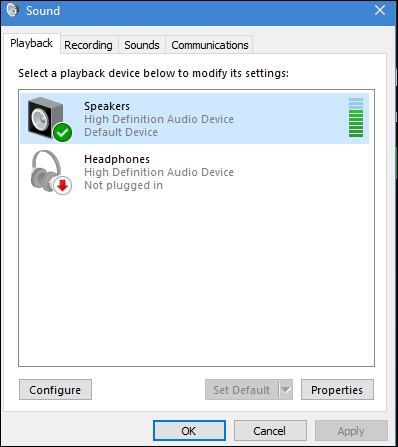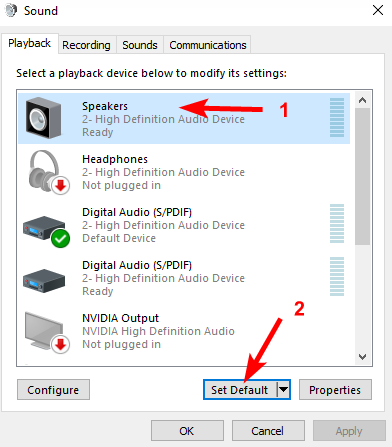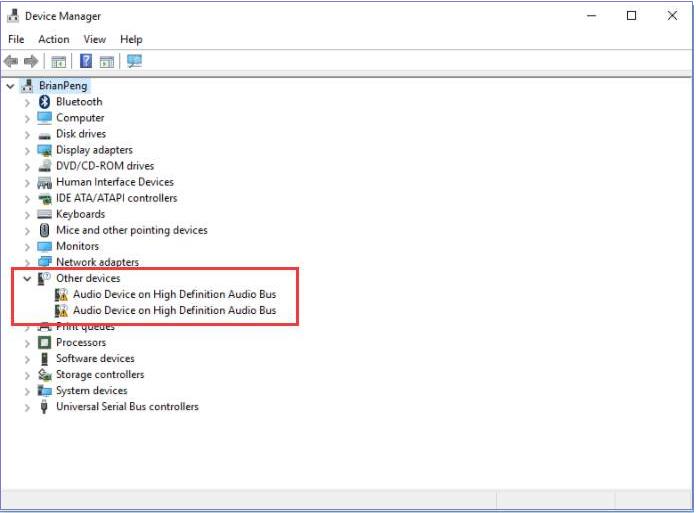If you are windows 10 users and facing “sound or audio issues” on your PCs, then you should run “Sound Troubleshooter” at first. This troubleshooter program automatically scans and fixes most of the issues. In case if the troubleshooter fails to detect “Sound or Audio related issues”, you can reinstall sound driver on Windows 10 to fix these issues.
While researching the 'audio not working (Code 10)' issue, it was suggested that sometimes Windows 10 audio drivers won't work on some sound controllers, and that using a Windows 7 or 8 sound driver might work. Unfortunately, this did nothing and Windows would report it. After upgrading to Windows 10 you might notice you have no sound. Don’t worry, it’s an easy to fix driver problem. Most times in order to fix Realtek High Definition Audio problems you just need to update your drivers. Confirm if it is a driver problem. First things first, you need to make sure that it actually is a Realtek driver problem. Method 4: Using the troubleshooter for audio devices. One of the good things about Windows 10 is that it has built-in troubleshooters designed to repair problems for specific programs. You can try running the troubleshooter dedicated for audio devices. Here’s how to do it: Click the Search icon on the taskbar.
Here, we are discussing about “broken drivers”, “Audio System not working”, “No Audio Device is installed”, “Your Audio hardware can’t play the file” and similar sound issues, and providing some recommended tips to fix the issues.
Install sound driver Windows 10
The audio driver software is required to communicate your audio device like Speakers, headphones, microphone and other devices with Operating System which you have. In other word, we can say that sound driver acts as mediator between audio device and Operating System like Microsoft Windows OS and others.
To check if audio driver is installed or not, go to “Device Manager” and expand “Sound video and game controllers” category, and see the list of audio device. In case if “Yellow Exclamation Mark” shows on your audio drivers, then you need to update or reinstall the drivers to fix this problem.
Upgrading computer from older version to new Windows version can sometimes damage System’s drivers like audio drivers. In this case, you can download the latest audio driver according to your sound card model and operating system versions like Windows 10 32-bit or 64-bit, from official website of your sound card manufacturer. After that, run the setup file and follow on-screen instructions to finish the installation process.
Many users have reported about “Realtek HD Audio driver issues on Windows 10” on various online platforms including Microsoft Official forums and Realtek forums site as well, and asked for the solution. For those who are not aware, Realtek High Definition (HD) Audio Driver is designed for Windows OS based devices that provide high-quality DTS, Dolby and Surround Sound.
Users reported that they are facing “broken drivers” and “Audio System not working” issue even after getting windows update. Sometimes, “No Audio Device is installed” error message appears on PC reported by users.
Some common “Sound or Audio error” messages are:
- CD audio device is in use by another application;
- WAV sound playback error detected;
- Broken drivers
- Audio System not working
- No Audio Device is installed
- Your audio hardware can’t play the current file.
- MIDI output error detected;
These sound related issues occur in your Windows 10 due to several reasons including missing or corrupted important System files, corrupted or outdated audio driver, malfunctioning in Audio driver, Windows 10 update fails to install, hardware problems and even malware or spyware issues.
Microsoft Company officially confirmed that latest windows 10 update has been developed to remove all the incompatible applications and drivers automatically. So, there is chance of getting “No Sound” issues on windows 10 if your audio driver is damaged or removed during windows 10 update install. You can fix “No Sound” issues by reinstalling audio drivers and several other solutions given below. Let’s go for the solution.
[Tips & Tricks] How to reinstall sound driver on Windows 10?
Procedure 1: Reinstalling sound drivers using “Control Panel”
Step 1: Click on “Start” button and type “Appwiz.cpl” in Windows Search and press “Enter” key to open “Programs and Features” window
Step 2: Locate your audio driver in the list

Step 3: Right click on it and choose “Uninstall” option
Step 4: In the confirmation dialog box, click on “Yes” to continue the uninstall process
Step 5: Once uninstalled, restart your computer and go to official websites of Realtek and install sound driver on Windows 10 PC
Procedure 2: Reinstalling sound drivers “Realtek HD Audio Driver”
Step 1: Press “Windows + R” key from keyboard to open “Run Dialog box”
Step 2: Type “devmgmt.msc” and hit “Enter” key to open “Device Manager”
Step 3: Locate “Sound, Video and Game Controllers” in the list and expand it
Step 4: Right-click on “Realtek High Definition Audio Driver” and click on “Uninstall”
Step 5: Once uninstalled, restart your computer and open the Device Manager again
Step 6: Expand the “Sound, Audio and Game Controllers” and right click on “Realtek High Definition Audio Driver” and click on “Scan for Hardware changes”. This process will automatically install audio driver on Windows 10
Step 7: If System fails to detect missing drivers and install its latest version automatically, you can visit the Official Realtek Website and download the latest Audio Driver as per your System configuration.
Procedure 3: Fixing the issue with incorrect Intel Audio Driver
Step 1: Press “Windows + X” key from keyboard and select “Device Manager”
Step 2: In the opened “Device Manager” window, expand the “Sound, Video and Game Controllers” section
Step 3: Find the “Realtek Device” (Yellow triangle with ‘?’ mark) and select it
Step 4: Choose “Devices by Conection” in the view menu
Step 5: Check the “Patent Device” and right click on Controller Device and open the “Properties”
Step 6: In the new window, check your driver’s version under “Driver” tab
Step 7: In case if your driver version is 9.21.0.3755, you have incorrect driver so click on “Uninstall” and allow the changes
Step 8: Finally, restart your computer and check if audio or sound issues is resolved.
Procedure 4: Update audio driver using “Device Manager”
Step 1: Press “Windows + X” key from keyboard and select “Device Manager”
Step 2: Expand “Sound, Video and Game Controllers” section
Step 3: Locate the device with Smart Sound Technology (SST) as part of the name.
Step 4: Right-click on it and select “Update Driver”
Step 5: In the new opened window, select “Browse my computer for driver software” and click on “Next”
Step 6: Now, select “High Definition Audio” and click on “Next”
Step 7: Once installed, restart your computer and please check if “broken audio drivers” or “No sound” issues is resolved.
Procedure 5: Check if “Windows Audio” and “Windows Audio Endpoint Builder” service is running
Step 1: Press “Windows + R” keys together from keyboard to open “Run Dialog Box”
Step 2: In then opened “Run Dialog Box”, type “services.msc” and hit “Ok” button
Step 3: In the opened “Services” window, locate “Windows Audio” and “Windows Audio Endpoint Builder” services in the list
Step 4: If their status is “Not Running”, then right-click on them one-by-one and choose “Start” option from menu
Step 5: Double-click on it to open its “Properties”
Step 6: In the opened “Properties” window, select “Automatic” from dropdown under “Startup type” section
Step 7: Finally, click on “Apply” and “Ok” to save the changes. Once done, please check if the “No sound problem” is resolved.
You may also read: Reinstall Realtek Audio Driver On Windows 10
Conclusion
I am sure this article helped you to “fix Your audio hardware can’t play the current file”, “fix MIDI output error detected”, “fix No Sound issue”, “fix Sound or audio driver issue” with several easy methods. You can choose either one or all procedures as per your System requirements and technical knowledge to fix these sound issues.
If you are unable to fix sound or audio issues with the solutions mentioned above, then it might possible that your System has already malware or spyware related issue. In this case, you can scan your computer with powerful antivirus software that has the ability to delete all malware or spyware, clean System registry, remove faculty software or driver and fix all types of bugs or errors.
Microsoft tried their best while creating Windows 10 as everyone had a lot of expectations from it. Windows 10 is better than its predecessors in many ways, but what makes it not so successful is bugs and errors. Windows 10 is full of bugs and errors. And no matter how much Microsoft tries to fix them with every update, some new ones always show up out of nowhere.
When people upgraded their computers to Windows 10, it all looked good at the start. But, within a few days (hours?), they started noticing many bugs and errors in it. Some of them got fixed in the first update, but soon, new ones took their place, and the cycle continued. One such error that has been bugging Windows 10 users is IDT High Definition Audio Codec Driver error. This error results in no sound from the computer. Usually, this issue occurs after upgrading your computer to Windows 10, or after installing any Windows 10 update. This normally happens when the driver is not up to date. But, it can also happen due to other reasons as well. This issue has been affecting a lot of Windows users, and if you are one of them, there’s nothing to worry. In this article, we will help you fix the problem. Just follow the methods mentioned below, one by one, until the issue is fixed.
How to Fix IDT HD Audio Error
There are just a few methods to fix this error. Follow and perform these methods carefully to solve the issue.
Working Method : –
On your keyboard, press the Windows logo key and X (at the same time) to get the quick-access menu.
1 – Click on Device Manager.
2 – Expand Sound, video and game controllers.
3 – Right-click on IDT High Definition Audio CODEC
4 – Select Update Driver software
5 – Click on Browse my computer for driver software.

6 – Select High Definition Audio Device
7 – Click on Next
8 – Click Yes on warning message
9 – Restart your computer.
Hope it is fixed. If it does not get fixed, move on to next method given below.
1. Confirm it’s a Driver Problem
Before beginning with solving the issue, you will have to make sure it is the driver that’s causing the problem. Because the error could have been caused by some other reason as well. Follow the steps confirm it’s a driver issue.
High Definition Audio Device Has A Driver Problem Windows 10 Startup
Step 1. Right-click on the Start menu button and select Device Manager.
Step 2. Here, expand Sound, video and game controllers.
Step 3. Under Sound, video and game controllers, you will find IDT High Definition Audio CODEC. Now, you have to make sure if there is a yellow question mark or an exclamation mark on its icon. If the yellow mark is present, then the driver is causing the problem.
Follow the next method to fix this problem.
2. Reinstall Driver
After confirming it’s the driver that’s been causing problems, we will reinstall the driver for IDT High Definition Audio CODEC. This method has worked for most users. Follow the steps mentioned below to perform this method.
Step 1. Right-click on the Start menu button and select Device Manager.
Step 2. Expand Sound, video and game controllers and right-click on IDT High Definition Audio CODEC. Select Update Driver.
Step 3. In the next step, select Let me pick from a list of device drivers on my computer.
Step 4. Now, you will see two or more options here. Select High Definition Audio Device. You don’t have to select IDT High Definition Audio CODEC. After that, click on Next.
Step 5. If a warning message appears, click on YES.
Step 6. After the driver installation process is complete, restart your computer.
This should solve the problem. But, if you are still facing the same issue, follow the next method.
3. Install Latest Driver from Website
As reinstalling the driver offline didn’t work, you will have to try installing the latest driver. For this, go to your computer’s manufacturer’s website, and download the driver setup file for IDT High Definition Audio CODEC. After downloading it, simply double-click on it and follow the on-screen instructions to install the driver.
This should fix the problem. If you are still facing the issue, follow the next method.

4. Install Driver in Compatibility Mode
Many drivers which were released for operating systems before Windows 10, which work perfectly with Windows 10. This also works backwards. Meaning, many drivers released for Windows 10, work pretty well for Windows’ editions before Windows 10. So, in this method, we will try to install the latest driver for older version Windows, in compatibility mode.
Step 1. The driver setup file which you downloaded in the last method, locate it. You have to right-click on it and select Properties.
Step 2. Go to Compatibility tab. Mark the box beside Run this program in compatibility mode for. After that, select an older version (Windows 8 or Windows 7) from the drop-down menu. Click on OK.
High Definition Audio Device Windows 10
Step 3. Now, double-click on the setup file to begin the installation process. Follow the on-screen instructions to install it.
Step 4. Restart your computer.
Download A Audio Device For Windows 10
This method should fix the problem for you. If it didn’t, follow the next method.
5. Enable IDT Audio Related Services
In this method, we will enable some IDT Audio related services. This might fix the problem for you. Here, you will have to change the Startup of three services to Automatic. Follow the steps to perform this method.
Step 1. Right-click on the Start menu button and select Run.
Step 2. Type services.msc and click on OK.
Step 3. Locate Windows Audio, and right-click on it. Select Properties.
Step 4. Under the General tab, select the Startup type as Automatic (Delayed Start) or Automatic. Click on Start, and then on OK.
Repeat the above two steps for these two services: Multimedia Class Scheduler and Windows Audio Endpoint Builder.
Step 5. When you are done, restart your computer.
This should fix the problem.
If you were able to solve this issue using some other method, or if you have any questions regarding this issue, please mention them below in comments.
